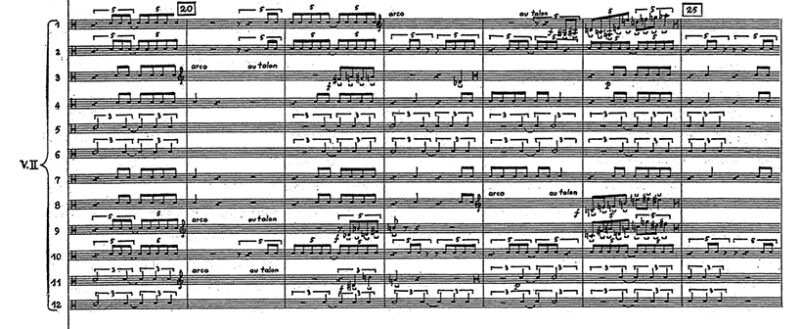Phitoprakta by Xenakis: The algorithmic elephant
When following the graphic score of Pithoprakta by Xenakis, along with the recording we can see that the piece is based on mathematical structures. In the graphical score, these structures looks very organic, as if the mathematical designs were drawn by hand. This is something very valuable when composing. If the strings were to enter one by one, orderly, we would see a straight line in the score (graphic or analog) bringing an extremely predictive musical behavior. It is important to break the straight lines of the design to achieve more organic shapes, and consequently a more organic listening. The score is still going to be schematic, but the structures will be as calculated as a tree can be, not a refrigerator. Pithoprakta is never reduced to ideal squared forms, which would be uninteresting for the ears.

The graphic notation that can be inferred from Pithoprakta is visually beautiful. The analog score has both musical and visual value.
When I “see” graphic scores by other composers, I experience different things:
- The score has nothing to do with the effect; it is randomly connected, usually in a very simplistic way. It seems to me that the performers do whatever they want. This could be worth doing. But usually not.
- The scores are very rigid, especially those that use graph paper. The music sounds like coming from a mechanical piano made from a roll inspired on a geometric delight without musical heart.

Xenakis´music is organized and visceral at the same time. And quoting the Greek (sorry for the easy association!), Xenakis breaks the commonplace conception of Apollo as an opposite of Dionysus. The guts of Dionysus and the arrow of Apollo converse. The warmth of wine, the dance, the beast come together with the intellectual distance, the direction, and predetermination of the archer. Gabriel Valverde, my composition teacher, used to say when talking about Xenakis: “An elephant has passed.” An algorithmic elephant, I would say!

As a composer I am interested in the mathematical construction of organic forms. Not rooted literally in the heart of mathematics, but in its concept. There are many contemporary composers who work with mathematical organic forms derived from nature, with sonic results that are generally highly schematic. Especially in our century, where organic forms are closely related to ecological concerns, the translation of data into music seems to be done by pushing a square button without guts and also without premeditation. Xenakis was overall a musician, who, guts and brain, ultimately assigns the parameters and decides what each algorithm means in the realm of music. A monster with two heads.
Following this line of thinking, there is, however, a question about the mathematical structures in Xenakis’s music related to his approach to musical form. In Pithoprakta, the different scenes succeed each other in blocks. These blocks are in dialogue with each other, like successive blocks of concrete (or other more fragile materials, like “blocks of gas” or “blocks of fluids”). Block, massive or ethereal are also melting into one another. But they are solid, concrete, clearly defined blocks. In the manner of Stravinsky, Gubaidulina, Ustvolskaya, Nono in his string quartet, and many others, the discourse in blocks attempts to disrupt centuries of a Western linear narrative discourse. Urgent matters in the mid-20th century.
I borrow the question of organic forms previously discussed in Pithoprakta, but now, applied to the general form of a piece. And also, bringing the use of organic mathematical forms in other aspects of the composition like sound structure and orchestration. Also into overall rhythmic organization, a complete new extensive chapter.
Somehow in my mind, unconsciously, an as unaware I could be of the influences of such a composition monster, I pay tribute to the beginning of Pithoprakta with my Música invisible for trombone, Water wonderfully played by Dalton Harris. In Water, I am using the rhythmical structures of water drops to create musical structures (listen with headphones please! the beginning is very soft).
I listen to Pithoprakta with nostalgia, like someone watching a Tarkovsky film. There is still so much to learn, but at the same time, it feels so far away, a blurry dot back then in the 20th century. Good old times.
Phitoprakta by Xenakis: The algorithmic elephant Read More »